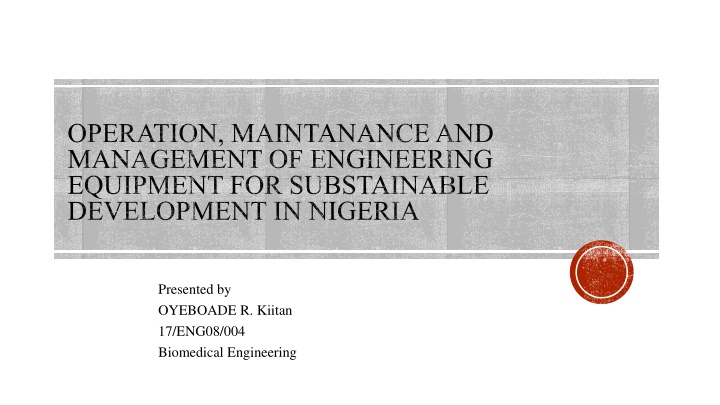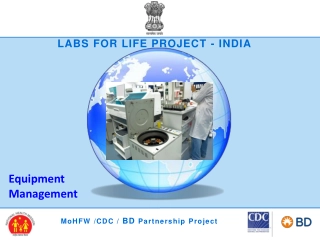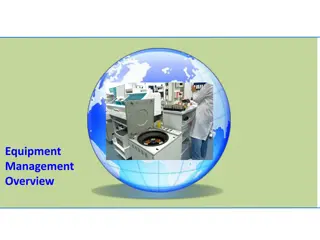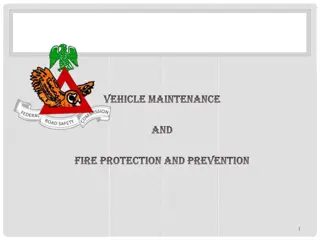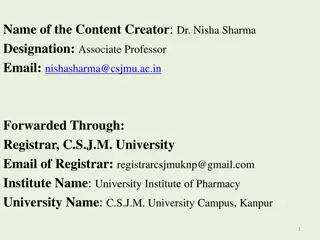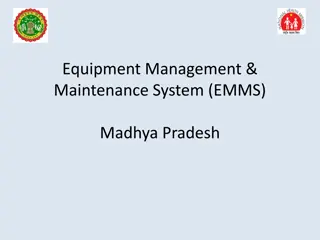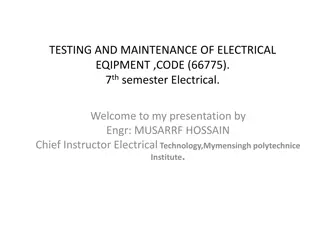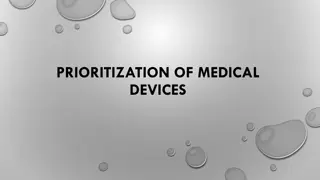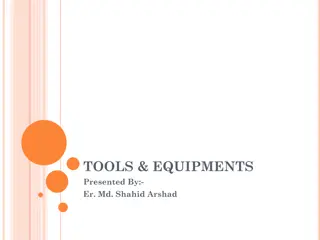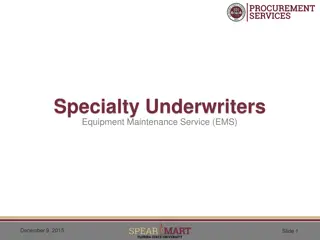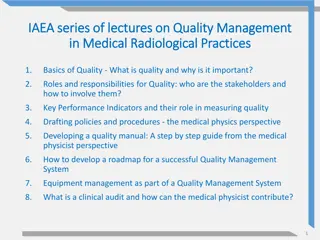Operation, Maintenance, and Management of Engineering Equipment for Sustainable Development
Engineering involves the design, construction, and maintenance of mechanical, electrical appliances for daily life. Sustainable management and development aim to meet present needs without compromising future resources, ensuring preservation for future use. Sustainable development is a global goal focusing on environmental, economic, and social sustainability. The concept of sustainable development emphasizes meeting present needs without jeopardizing future generations' ability to meet their own needs.
Download Presentation

Please find below an Image/Link to download the presentation.
The content on the website is provided AS IS for your information and personal use only. It may not be sold, licensed, or shared on other websites without obtaining consent from the author.If you encounter any issues during the download, it is possible that the publisher has removed the file from their server.
You are allowed to download the files provided on this website for personal or commercial use, subject to the condition that they are used lawfully. All files are the property of their respective owners.
The content on the website is provided AS IS for your information and personal use only. It may not be sold, licensed, or shared on other websites without obtaining consent from the author.
E N D
Presentation Transcript
OPERATION, MAINTANANCE AND MANAGEMENT OF ENGINEERING EQUIPMENT FOR SUBSTAINABLE DEVELOPMENT IN NIGERIA Presented by OYEBOADE R. Kiitan 17/ENG08/004 Biomedical Engineering
INTRODUCTION Engineering is that branch of human training, endeavor or learning which majors in the design, construction, manufacture, repair or maintenance of mechanical, electrical/electronic appliances, facilities for use by man in the course of his daily life. Put in another way, Engineering is a scientific field or job that involves taking our scientific understanding or knowledge of the natural world and using it to invent, design and build things to solve problems and achieve practical goals. Or The action of working artfully to bring about something.
OPERATION Operational sustainability is a method of evaluating whether a Process/business can maintain existing practices without placing future potential resources at risk. It can also be defined as operations that meet the present needs without compromising on the ability to meet future needs.
MANAGEMENT Sustainable management means ensuring that it is preserved in a way for future use. Sustainability management is needed because it is an important part of ability to successfully maintain the quality of life on our planet. Which can be applied to all aspect of life including the healthcare.
SUSTAINABILITY Sustainable development is increasingly becoming a goal to which numerous countries throughout the world aspire. Overall sustainability has been defined in many ways, and is often considered to have three distinct components: environmental sustainability, economic sustainability and Social sustainability. These three factors when considered separately usually pull society in different directions (e.g., economic sustainability may be achieved at the expense of environmental and social sustainability). Overall sustainable development in general requires the simultaneous achievement of environmental, economic and social sustainability.
SUSTAINABILITY AND SUSTAINABLE DEVELOPMENT To understand the concepts of engineering sustainability, it is important to consider the concept and definitions of sustainability and sustainable development. Sustainable development was defined by the 1987 Brundtland Report of the World Commission on Environment and Development as development that meets the needs of the present without compromising the ability of future generations to meet their own needs. This definition implies that actions of present societies should not threaten cultures or living standards for societies. The degree to which sustainable development can be achieved by countries varies, since countries differ according to such characteristics as size, wealth, living standards, culture, and political and administrative systems. The basic motivations and desires of societies, countries, cultures and people to advance appear not to have changed, and these aspirations usually require increasing use of engineering and consumption of resources.
ENGINEERING AND SUSTAINABILITY The concept of engineering sustainability is simply the application of the general definitions of sustainability to engineering. In other words, engineering sustainability involves the provision of engineering services in a sustainable manner, which in turn necessitates that engineering services be provided for all people in ways that, now and in the future, are sufficient to provide basic necessities, affordable, accessible, not detrimental to the environment, and acceptable to communities and people.
KEY REQUIREMENTS FOR ENGINEERING SUSTAINABILITY There are several distinct components to the manner in which engineering can be practised sustainably in society, each of which is a requirement for engineering sustainability: Sustainable resources Sustainable processes Increased efficiency Reduced environmental impact Fulfilment of other aspects of sustainability
MAINTANANCE AND MANAGEMENT OF ENGINEERING FOR SUSTAINABLE DEVELOPMENT Due to high costs associated with replacement of parts or equipment failing due to lack of preventive maintenance, equipment owners are increasingly emphasizing the need to maintain and calibrate equipment as well as replace parts in an organized manner. Due to rapid changes in technology and engineering, scientific equipment has been evolving at the same pace.
In general, the goal of maintenance is to eliminate or avoid unnecessary or unplanned downtime due to failure. Good maintenance practice can cut production costs immensely, whereas poor maintenance procedures can cost a company millions of cash/fund to effect repairs and correct poor quality and production loss. In the bid to correct and reduce this menace, a good sustainable maintenance strategy and practice needs to be adopted.
TYPES OF MAINTENANCE Corrective Maintenance Preventive Maintenance Predictive Maintenance Zero Hour Maintenance(Overhaul) Periodic Maintenance (Time Based Maintenance TBM)
CHALLENGES OF MAINTENANCE AND MANAGEMENT PLAN IN NIGERIA Shortage of spares and local maintenance expertise Outdated technology Lack of adequate funding to support maintenance Lack of proper training
CONSIDERATION WHEN MAKING MANAGEMENT AND MAINTENANCE PLAN When designing, the Maintenance Plan should take into account two important considerations affecting some equipment in particular. Firstly, some equipment are subjected to legal rules that regulate their maintenance, forcing them to perform certain activities within an established frequency. Secondly, some of the maintenance activities can not be performed with the regular maintenance equipment because it requires knowledge and / or specific resources that are only up to the manufacturer, distributor or a specialist team.
BIOMEDICAL EQUIPMENT FOR SUSTAINABLE DEVELOPMENT IN NIGERIA As regards to the subject of this paper the followings will be required to have a sustainable development in Nigeria in operation, maintenance and management of engineering equipment in our hospital/medical health facility Efficient equipment management for biomedical engineering department which will comprise the followings: Maintenance labels Standard Operation Procedure (SOP) Equipment inventory management Maintenance program Regular Audit/Review of inventory Replacement and disposal policy Support spare parts inventory Adequate training (user/staff/support) Tools
CASE STUDY: COVID-19 Using the case of COVID-19 pandemic as an example in Nigeria, it is totally clear that Nigeria has no proper/accurate inventory records and plans which led to Lack of appropriate planning Lack of equipment Lack of isolation centres Lack of inventory records for the medical equipment Lack of preparedness
EQUIPMENT USED DURING THE COVID-19 PANDEMIC To prevent Infectious disease transmission, elimination (physically removing the hazard) and substitution (replacing the hazard) are not typically option for healthcare setting.
N95 RESPIRATOR this is a respiratory protective device designed to achieve a very close facial fit and very efficient filtration of airborne particles. It helps wearer from breathing in some hazardous substances
FACEMASK this used to prevent the spread of disease. It helps limit the spread of germs. In case of the COVID-19 When someone talks, coughs or sneezes they may release tiny drops into the air that can infect others.If someone is ill a face masks can reduce the number of germs that the wearer releases and can protect other people from becoming sick.
EYE PROTECTOR It prevent the virus to enter the body through the eyes when positive COVID- 19 patient coughs, sneezes, or talks.
VENTILATOR is a machine that provides mechanical ventilation by moving breathable air into and out of the lungs, to deliver breaths to a patient who is physically unable to breathe, or breathing insufficiently
DISINFECTANT BOT All over the world, hundreds of engineers, scientists and software developers are at work building a robotic army with a bold mission: to help prevent the spread of coronavirus.
RECOMMENDATION With the challenges facing Nigeria and lack of maintenance planning in Nigeria I will recommend the following: A maintenance policy must be put in place to address the procurement of equipment Procurement should the prepared by the appropriate professional individual Proper training should be provided for the right personnel so that it can ensure the maximum utilization of the equipment. Adequate funding for the management and maintenance of medical equipment must be provided The federal, state, local government and private concerns must ensure that funds allotted to the cause are properly disbursed to the management/maintenance plans. This commitment will ensure adequate provision for failed equipment and developed a sustainable equipment for future use. Our leaders are encouraged to pay adequate attention to human development as well as the plight of masses under their jurisdiction
CONCLUSION It is necessary that several key factors need to be considered and appropriately addressed to achieve engineering sustainability, which itself is a crucial component of overall sustainability for human activity and development. The key factors include appropriate planning, maintenance, management of medical equipment for sustainability criteria, the use of sustainable processes, enhancement of the efficiency of resource utilization and engineering processes, environmental stewardship in engineering activities so as to mitigate environmental impacts, and fulfilment of other aspects of sustainability, such as economics and equity.
